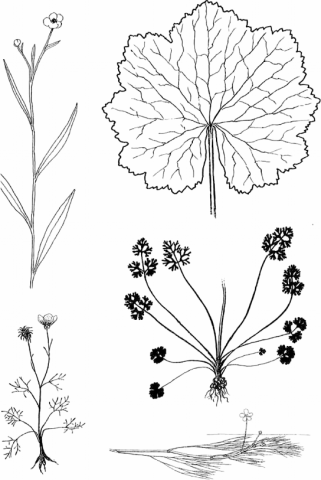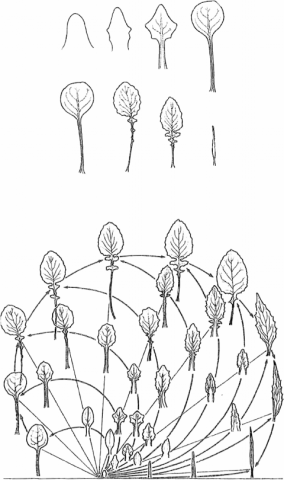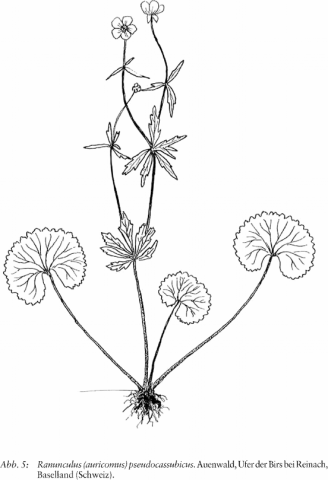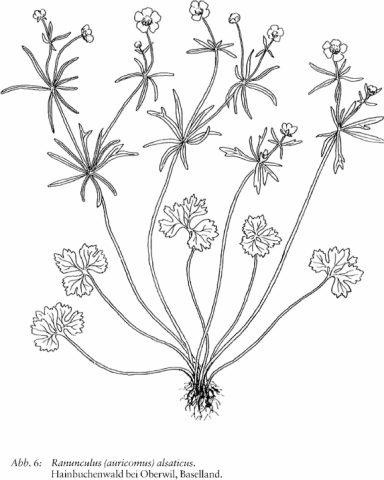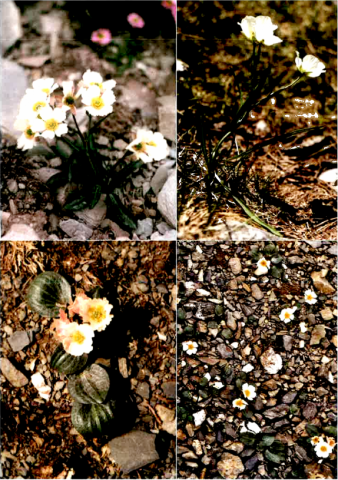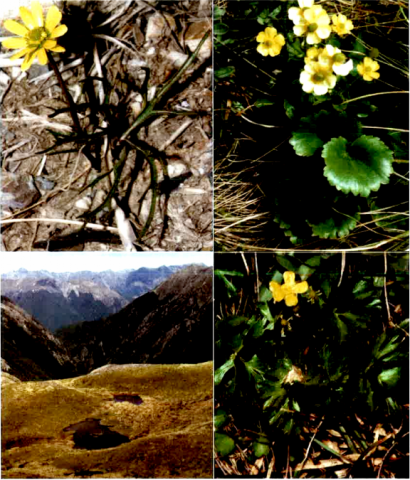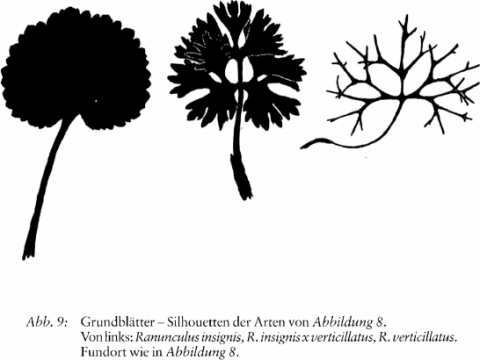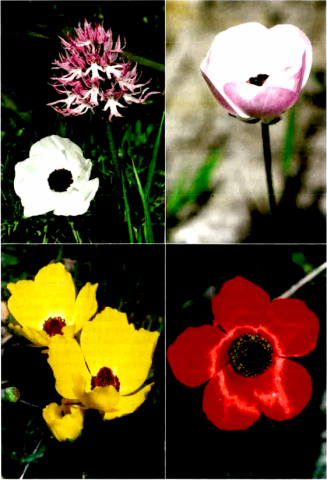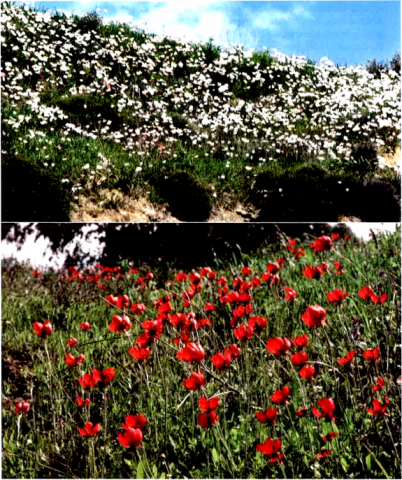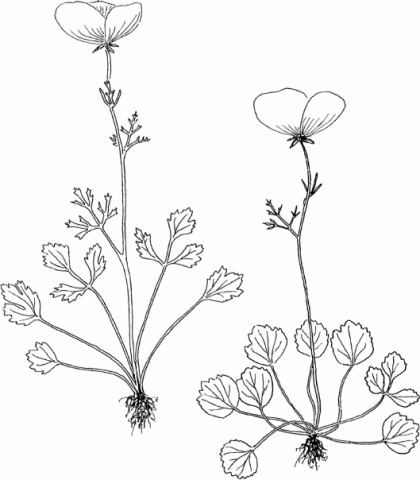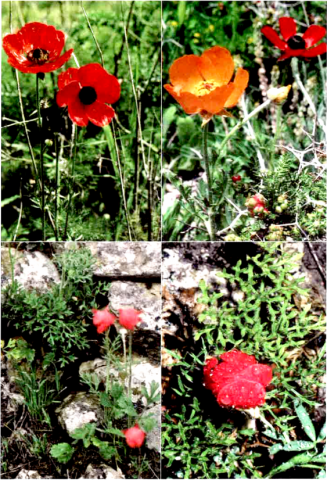Gestaltmotive in der Gattung Ranunculus
Export Article Citation as
- Download price : €6
Abstract:
Formative motifs in the genus Ranunculus
According to ‘Flora Europaea’ (2nd ed. 1993) almost every available habitat is colonised by the 135 species of the genus (not family!) Ranunculus. In parallel with this, manifests an enormous plasticity in the formation of the vegetative parts, the leaves, which have an almost inexhaustible multiplicity of forms, a diversity the like of which is shared by no other genus of flowering plants. Each of these forms reflects the structure and living conditions of the respective landscape occupied, from moist woodland to desert; from still waters to rushing brook and from maquis, that is green only in winter, to the nival zone in the mountains. Where markedly different habitats abut each other, bastardisation can occur with intermediary forms arising between the respective characteristic species (two examples are documented).
In contrast, apart from a few prominent exceptions, flower formation does not show a particularly remarkable variation - the plasticity and diversity of the possibilities remains, so it appears, With the vegetative part. The exceptions concern two widely separated geographical regions: the eastern Mediterranean and the Alps of New Zealand. In the present paper the latter is dealt with only aphoristically - characteristically for New Zealand, they are predominantly species with large white flowers with a strong tendency to hybridisation (cf. FISHER 1965). The other example, dealt with more thoroughly in this paper, concerns Ranunculus asiaticus, a remarkable species in several respects. One is that it falls completely outside the bounds of what is typical of the genus through not only the size but also the colour diversity of its extraordinarily large flowers. Another is the unusual diversity of its leaf forms within a population. Obviously it is a case of a species which has developed above the natural level of the genus to a level that is independent of it in the central, if not the oldest, region of intervention in nature by human cultivation. Its development is comparable only with cultivars although in this case it is of course unintentional.
References
- AESCHIMANN, D. & al. (2004): Flora Alpina Vol. 1. Bern
- ALLAN, H. H. (1961 ): Flora of New Zealand Vol. I. Wellington (»Reprinted without antendment 1982«: Ranunculus inzwischen überholt! — vgl. FISHER 1965
- BOCKEMÜHL, J. (1982): Bildebewegungen im Laubblattbereich höherer Pflanzen. In: Schad, W (Hrsg.), Goetheanistische Naturwissenschaft Bd. 2 (Botanik), S. 17-43. Stuttgart
- BRAUN-BLANQUET, J. (1948): La Végétation alpine des Pyrénées Orientales. Monografia de la estacion de estudios pirineicos. Barcelona
- BRODTBECK‚ T. (1988 etc): Ranunculi auricomi Helvetici et transhelvetici I: Vier Sippen aus der Basler Region. Bauhinia 9/1: 77-101
- BRODTBECK‚ T. & al. (1997): Flora von Basel und Umgebung 1980-1996, Teil 1. Liestal
- CADEVALL I DIARS‚ J. (1913-1937): Flora de Catalunya. Barcelona
- CARLSTRÖM, A. (1987): A Survey of the Flora and Phytogeography of Rhodos, Simi, Tilos, and the Marmaris Peninsula. Lund
- CASTROVIEJO, S. & al. (1986): Flora Iberica Vol. I. Madrid
- COOK, C. D. K. (1966): On the determination of leaf form in Ranunculus aquatilis. New Phyt. 68: 469-480 (zitiert nach HEGI 1965)
- COSTIN, A. B. & al. (1979): Kosciusko Flora. Sydney
- DANIN, A. (1983): Desert Vegetation of Israel and Sinai. Jerusalem
- DANIN, A. (2004): Distribution Atlas of Plants in the Flora Palaestina Area. Jerusalem
- DAVIES, P. H. (1965-1988): Flora of Turkey and the East Aegean Islands Vol. 1. Edinburgh
- EKSTAM, U. & al. (1984): Ölands och Gotlands växtvärld. Stockholm
- FIELDING, J.‚ STURLAND, N. (2005): Flowers of Grete. Kew
- FISHER, F. J. F. (1965): The Alpine Ranunculi of New Zealand. Wellington
- FOURNIER, P. (1946): Les Quatre Flores de la France, 2me tirage. Paris
- HEGI, G. (1965): Illustrierte Flora von Mitteleuropa III. Bd., 3. Teil, 2. Aufl. München
- HESS, H. E., LANDOLT, E., HIRZEL, R. (1970): Flora der Schweiz Bd. 2. Basel, Stuttgart
- HOHENESTER, A., WEISS, W (1993): Exkursionsführer für die Kanarischen Inseln. Stuttgart
- JAHN, R., SCHÖNFELDER, P. (1995): Exkursionsflora für Kreta. Stuttgart
- JALASS, J., SUOMINEN, J. (1989): Atlas Flora Europaeae 8: Nymphaeaceae to Ranunculaceae. Helsinki
- KUNKEL, G. (1980): Die Kanarischen Inseln und ihre Pflanzenwelt. Stuttgart
- MOOR, M. (1962): Einführung in die Vegetationskunde der Umgebung Basels in 30 Exkursionen. Basel
- MOSSBERG, B., STENBERG, L. (2003): Den nya nordiska floran. Stockholm (sehr gute Zeichnungen aller Arten)
- NEHME, M. (1980): Fleurs sauvages du Liban. Beyrouth
- PIGNATTI, S. (1982): Flora d’Italia Vol. I. Bologna
- POST, G. E. (1883, reprint 1980): Flora of Syria, Palestine, and Sinai. Delhi
- SUCHANTKE, A. (1996): Natur in Israel und Palästina: Brennpunkt und Synthese weltweiter Einflüsse. In: Suchantke, A. (Ed.), Israel und Palästina im Brennpunkt natur- und kulturgeschichtlicher Entwicklungen. Stuttgart
- SUCHANTKE, A. (2008): Altes junges Neuseeland. In: Suchantke, A., Zum Sehen geboren. Stuttgart
- TUTIN, T. G. & al. (1993): Flora Europaea Vol. 1. Second edition, Cambridge
- VAHLE, H.-C. (2007): Die Pflanzendecke unserer Landschaften. Stuttgart
- VIGO I BONADA, J. (1976): L’ Alta Muntanya Catalana - Flora i Vegetació. Barcelona
- WILSON, H. D. (1976): Vegetation of Mount Cook National Park, New Zealand. National Park Authority, Scientific Papers Number 1. Wellington
- ZOHARY, M. (1966): Flora Palaestina Vol. 1. Jerusalem
- ZOHARY, M. (1973): Geobotanical Foundations of the Middle East. Stuttgart, Amsterdam
- ROSSLENBROICH, B. (2006): Zur Autonomie-Entstehung in der Evolution — Eine Übersicht. Tycho de Brahe-Jahrbuch für Goetheanismus 2006: 157-200
- STREFFER, W. (2007): Entwurf zu einer Biologie der Freiheit am Beispiel der Singvögel. Jahrbuch für Goetheanismus 2007: 33-76
- STREFFER, W. (2009): Klangsphären. Motive der Autonomie im Gesang der Vögel. Stuttgart
- SUCHANTKE, A. (2002): Metamorphose — Kunstgriff der Evolution (Abb. 53: Iris Iortetii). Stuttgart
- ZOHARY, D., HOPF, M. (1993): Domestication of Plants in the Old World. 2nd ed. Oxford


